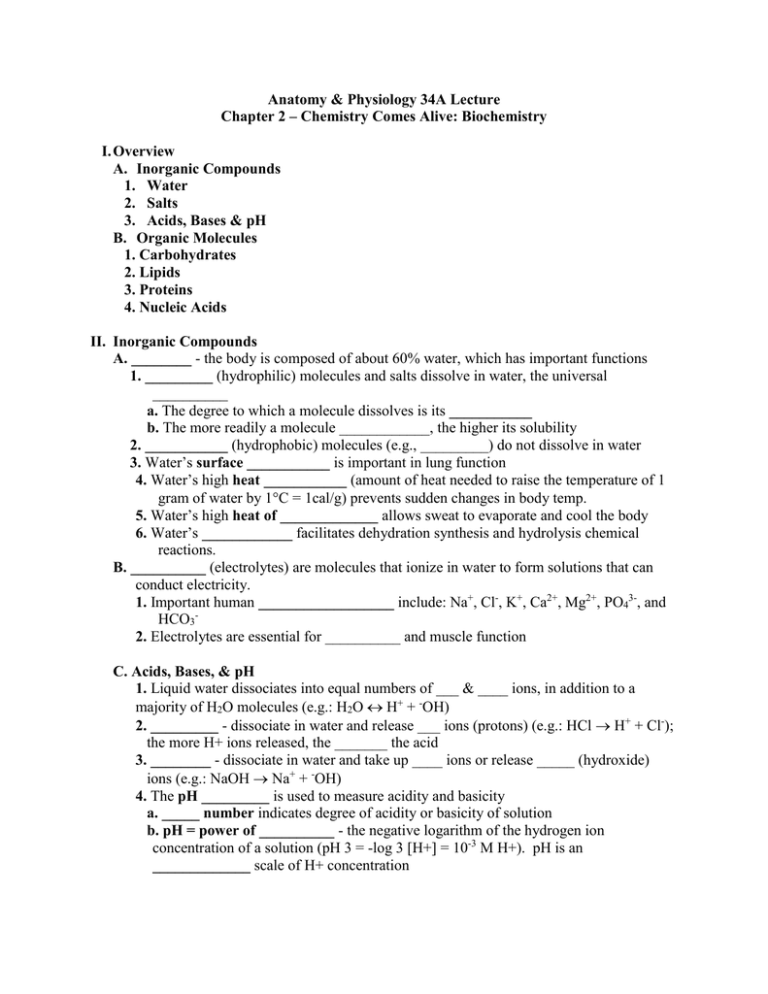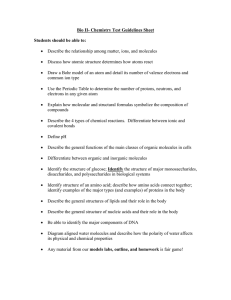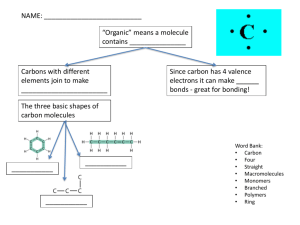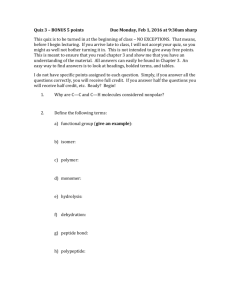Biochemistry
advertisement

Anatomy & Physiology 34A Lecture Chapter 2 – Chemistry Comes Alive: Biochemistry I. Overview A. Inorganic Compounds 1. Water 2. Salts 3. Acids, Bases & pH B. Organic Molecules 1. Carbohydrates 2. Lipids 3. Proteins 4. Nucleic Acids II. Inorganic Compounds A. ________ - the body is composed of about 60% water, which has important functions 1. _________ (hydrophilic) molecules and salts dissolve in water, the universal __________ a. The degree to which a molecule dissolves is its ___________ b. The more readily a molecule ____________, the higher its solubility 2. ___________ (hydrophobic) molecules (e.g., _________) do not dissolve in water 3. Water’s surface ___________ is important in lung function 4. Water’s high heat ___________ (amount of heat needed to raise the temperature of 1 gram of water by 1C = 1cal/g) prevents sudden changes in body temp. 5. Water’s high heat of _____________ allows sweat to evaporate and cool the body 6. Water’s ____________ facilitates dehydration synthesis and hydrolysis chemical reactions. B. __________ (electrolytes) are molecules that ionize in water to form solutions that can conduct electricity. 1. Important human __________________ include: Na+, Cl-, K+, Ca2+, Mg2+, PO43-, and HCO32. Electrolytes are essential for __________ and muscle function C. Acids, Bases, & pH 1. Liquid water dissociates into equal numbers of ___ & ____ ions, in addition to a majority of H2O molecules (e.g.: H2O H+ + -OH) 2. _________ - dissociate in water and release ___ ions (protons) (e.g.: HCl H+ + Cl-); the more H+ ions released, the _______ the acid 3. ________ - dissociate in water and take up ____ ions or release _____ (hydroxide) ions (e.g.: NaOH Na+ + -OH) 4. The pH _________ is used to measure acidity and basicity a. _____ number indicates degree of acidity or basicity of solution b. pH = power of __________ - the negative logarithm of the hydrogen ion concentration of a solution (pH 3 = -log 3 [H+] = 10-3 M H+). pH is an _____________ scale of H+ concentration 2 c. Acid is ______ than pH 7; the lower the number, the more ____, the more acidic. A decrease of 1 pH increases acidity ____ fold d. Neutral is pH ___. In pure water (pH7) H+ = -OH e. Base is _______ than pH 7; the higher the number, the less ___, the more basic. An increase of 1 pH increases basicity ___ fold 5. Blood pH must be maintained within _____-______ pH. a. H+ ion concentrations lower or higher than this range can interfere with ___________ bonding and Van der Waals forces holding organic molecules together 6. ____________ - chemicals that take up excess H+ or -OH ions and keep the pH constant a. Example: carbon dioxide and water in the blood combine to form weak ___________ _______, which dissociates into hydrogen ions and bicarbonate ions. The ______________ is a buffer that can take up excess H+ ions. (CO2 + H2O ↔ H2CO3 H+ + HCO3-) III. ____________molecules compose living (or previously living) things A. ___________ molecules always contain carbon and hydrogen 1. _______ has 4 electrons in its outer shell, therefore can form up to ___ covalent bonds with other atoms (i.e., H, O, N, S) 2. This property allows carbon to become the ____________ of organic molecules 3. Functional groups, such as carboxyl (-________ = acid) and hydroxyl (-____ = base), methyl (-____), amine (-____), and phosphate (-______) can be bonded to carbon groups B. Four classes of organic ____________ are: carbohydrates, lipids, proteins, and nucleic acids IV. ______________ – hydrophilic molecules that contain C, H, and O in a ratio of about 1C:2-H:1-O; function: primary ________ source & structural role in cells. (Energy = ___ kcal/gram) A. ______saccharides - simple sugars with 3-7 carbon atoms in [CH2O]n form; the basic ____________ blocks of carbohydrates. pentose sugars have ___ carbons, hexose sugars have ___ carbons. 1. _________ (C6H12O6) - primary energy source for cells (______ sugar) 2. __________ (C6H12O6) - ___________ sugar 3. ______________ (C6H12O6) - _________ sugar B. ____saccharides - two ________saccharides bond together 1. ____________ - glucose + fructose 2. ____________ - glucose + glucose 3. ____________ - glucose + galactose 3 C. ________saccharides - polymers of many monosaccharides (usually __________ molecules) covalently bonded together 1. ___________ - storage form of glucose in animals; stored in our ______ and muscle cells, broken down to glucose when needed 2. __________ - storage form of glucose in plants; stored in starch granules in plant cells, digested to __________ in our bodies 3. ___________ - main component of plant cell walls; also known as _________; we can’t digest this because the covalent bonds between the glucose molecule are slightly different than those in starch and glycogen 4. Most carbohydrates are broken down to __________, which is used in cellular respiration to produce _______ energy V. _________ - molecules composed of CHO in a variable ratio; functions: long-term _________ storage, adipose tissue insulates and cushions organs. (Energy = ___ kcal/gram) Lipids are ___________, do not mix with water. Types of lipids include: A. ________ ________ - hydrocarbon chain with carboxylic acid group at one end and a methyl group at the other end 1. ____________ - have no double bonds between carbons; _____________ fats, mostly from animal sources and hydrogenated plant oils; _________ at room temp. 2. ____________ - have one or more double bonds between carbons; __________ oils, from plant sources, _________ at room temp. B. _______________ - three fatty acids bonded to one ___________; nonpolar molecule; excess in blood contributes to heart disease C. __________lipid - two fatty acids (nonpolar) and a ___________ group (polar) bonded to one glycerol; found in ______ membranes D. ________ - have a backbone of 4 fused carbon rings with different functional groups; includes cholesterol and several hormones 1. _______________ - manufactured in animal ________, used in cell membranes, bile, and steroid hormones. Circulates in the blood in two main forms: a. _______ (Low Density Lipoprotein) - “_____” cholesterol, excess in blood clogs arteries b. _______ (High Density Lipoprotein) - “_______” cholesterol, recycles cholesterol back to liver 2. ______________ hormones include the ______ hormones estrogen, progesterone, and testosterone E. ______________ are 20 carbon compounds derived from the fatty acid arachadonic acid 1. Include leukotrienes, thromboxanes, and _________________ 2. These are _____________ molecules in inflammation, blood clotting, and control of blood vessel diameter 4 VI. __________ - large organic molecules consisting of chains of 50 or more amino acids composed of carbon, hydrogen, oxygen, ________, and sometimes sulfur. (Energy = ___ kcal/gram) A. Structural proteins - give strength and shape to different tissues (e.g.: keratin in hair & nails, collagen in connective tissues, _________ proteins, etc.) B. Functional proteins - such as __________, hormones, membrane proteins, antibodies, etc., are proteins that facilitate metabolic reactions. C. _________ ________ - basic building blocks of proteins; there are ___ different amino acids, each of which has the following bonded to a central ________ atom (see book for the 20 amino acid names) 1. Amine group (-_____) 2. Carboxylic acid group (-______) 3. Variable “___” (radical) group; some “R” groups are _______ (hydrophilic), and some are ____________ (hydrophobic) 4. ____________ atom D. Amino acids may be ___________ or nonessential 1. Nonessential AAs are the ____ that are synthesized by the body 2. Essential AAs are the ____ that cannot be synthesized by the body, thus must be obtained by eating complete proteins E. Peptide – two to nine amino acids linked together by __________ ________, formed between the amine group of one amino acid and the carboxyl group of another (HOOCNH2) 1. ______________ – 10-50 bonded amino acids 2. ____________ – polypeptide of more than 50 amino acids F. Levels of Protein Organization 1. __________ Structure - linear sequence of amino acids bonded together. All polypeptides have specific amino acid _________ 2. ___________ Structure - twisting or folding of the polypeptide chain (e.g.: alpha ________ or beta-pleated sheet), formed by hydrogen bonding between negative C=O and positive N-H 3. ___________ Structure – folding and coiling of a polypeptide (e.g.: to _________ or ___________) due to interactions among R groups and surrounding water 4. _______________ Structure – association of ___ or more polypeptide chains together (e.g.: hemoglobin has 4 polypeptide chains) 5. Proteins must _______ into precise shapes to function properly 6. Proteins, such as enzymes, can be ______________ (nonfunctional shape change) by heat or strong pH G. Proteins, lipids, and carbohydrates can combine to form ______proteins, glycolipids, or ______proteins 5 VII. Nucleic Acids - include DNA, RNA, and ATP; functions include cellular reproduction (_____), protein manufacturing instructions (DNA & ______), and cellular energy source (____) A. _____________ - basic building block of nucleic acids; composed of a phosphate group, a pentose sugar, and a nitrogenous base B. ______ (Deoxyribonucleic Acid) 1. Found in ________________, mostly in the cell nucleus 2. Forms _______ (specific sequences of DNA) that regulate the growth & reproduction of cells and direct the order in which amino acids are put together to form ___________ 3. DNA is a double-stranded _________ (like a twisted ladder) held together by hydrogen bonds and is composed of: a. ______________ sugar and ____________ groups form the side rails of the “ladder” b. Nitrogenous _______ held together by __________ bonds form the ladder steps. These bases include: 1) Thymine (__) 2) Adenine (__) 3) Cytosine (__) 4) Guanine (__) C. ______ (Ribonucleic Acid) 1. Works with DNA for __________ synthesis 2. Is mostly a __________-stranded molecule 3. Has __________ sugar 4. Has the same nitrogenous bases as DNA, except it has __________ instead of thymine D. _____ (Adenosine Triphosphate) 1. Is a nucleotide composed of _________, a ribose sugar, and 3 ___________ groups held together with high energy bonds 2. ATP is formed via the process of cellular _________, during which glucose bond energy is transferred to ATP bonds 3. Functions as the main ________ source in cells due to energy in the phosphate bonds 4. Other molecules related to _____ include cAMP, NAD+, and FADH a. cAMP is a cell ____________ molecule b. NAD+ & FADH are _______ transfer molecules in cell respiration








